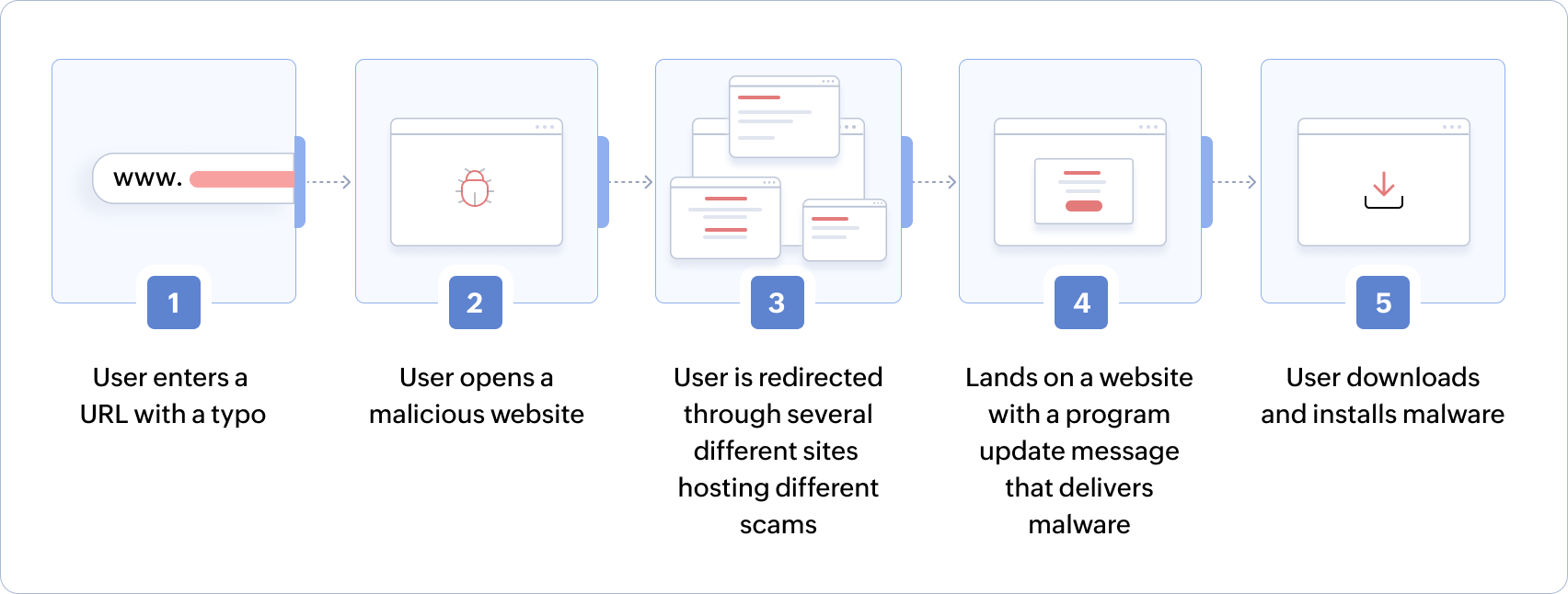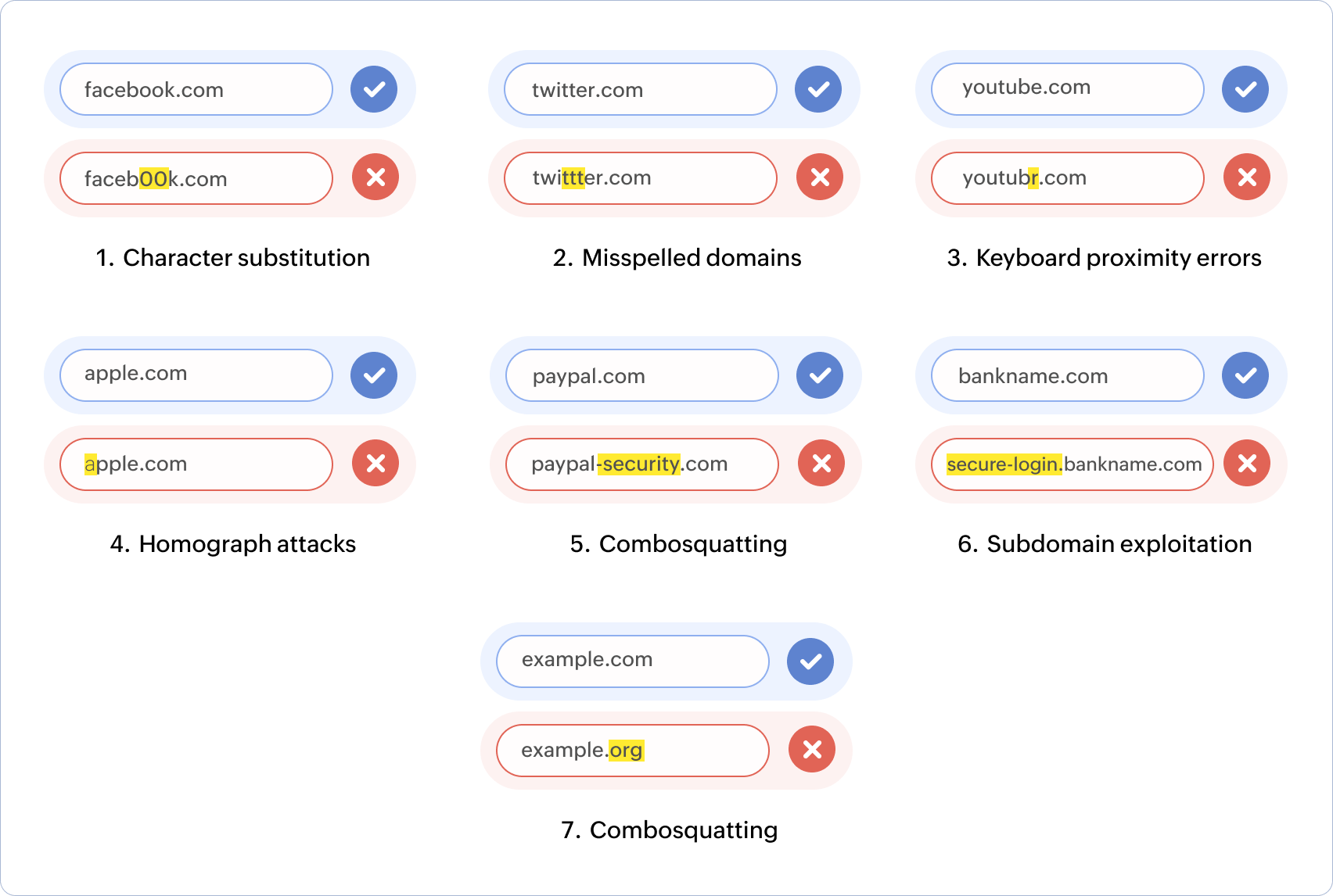Related content
What is typosquatting?
Typosquatting, sometimes referred to as URL hijacking, is a cyberattack technique where attackers register domain names that closely resemble legitimate websites. These domains exploit typographical errors or misspellings made by users when typing website addresses into their browsers. The primary goal of typosquatting is to redirect unsuspecting visitors to fraudulent websites designed to steal sensitive data, spread malware, or generate illegitimate profits through ads or affiliate links.
For example, a minor error in typing “www.facebook.com” as “www.facebokk.com” could lead to a malicious website designed to mimic Facebook, tricking users into entering login credentials. In cybersecurity, typosquatting represents a severe threat, preying on human error and relying on the assumption that users may not notice slight deviations in URLs.
Why is typosquatting also called URL hijacking?
The term URL hijacking emphasizes how attackers hijack legitimate web traffic. By mimicking trusted website URLs, typosquatters divert users away from genuine websites, undermining trust and security in online interactions.
How typosquatting works
Typosquatting operates on the principle of exploiting human error and predictable online behavior. Attackers carefully craft malicious strategies to manipulate how users interact with websites. Here's a breakdown of how this attack vector functions:
1. Domain name registration
Attackers purchase domains that resemble popular websites, using slight misspellings or variations of the legitimate URL. These domains often mimic high-traffic sites such as e-commerce platforms, social networks, or financial services.
2. Redirection to malicious websites
Once users mistakenly land on a typosquatted domain, they may be redirected to:
- Phishing pages, designed to steal sensitive information.
- Malware distribution sites, tricking users into downloading harmful software.
- Ad-heavy pages, generating revenue for attackers.
3. Imitation of legitimate websites
Sophisticated typosquatting domains replicate the design and branding of the original site to make detection difficult. This includes using similar logos, layouts, and interfaces.
4. Social engineering tactics
Attackers enhance the effectiveness of typosquatting by employing deceptive messages, pop-ups, or prompts to encourage users to act quickly—such as entering login credentials or downloading updates.
5. Targeting high-traffic brands
Popular brands are often targets since their vast user bases increase the likelihood of errors. Attackers analyze the most common misspellings of these domains to maximize their chances of success.

Types of typosquatting
There are several categories of typosquatting, each tailored to exploit specific types of user errors. Below are the most common types:
1. Character substitution
Attackers replace one or more characters in the original domain with similar-looking ones, such as “faceb00k.com” (using zeroes instead of "o").
2. Misspelled domains
Domains based on frequent spelling errors, like “twittter.com” (adding an extra "t"), prey on user inattention.
3. Keyboard proximity errors
These errors occur when users press nearby keys accidentally. For instance, “youtubr.com” instead of “youtube.com.”
4. Homograph attacks
These involve using characters from different alphabets that look similar to English letters, such as “аpple.com” (with a Cyrillic “а”) instead of “apple.com.”
5. Combosquatting
Attackers append additional words or phrases to a brand name, creating domains like “paypal-security.com” or “amazon-checkout.com.”
6. Subdomain exploitation
This involves creating convincing subdomains such as “secure-login.bankname.com,” tricking users into believing they are on a secure page.
7. Alternative TLDs
Attackers register the same domain name with a different top-level domain (TLD), such as “example.org” instead of “example.com,” to exploit user assumptions about domain endings.

Impacts of typosquatting
Typosquatting can cause significant harm to individuals, businesses, and even entire industries. The consequences go beyond simple inconvenience, often resulting in substantial financial and reputational damage.
1. Financial losses
- For individuals: Victims may lose money directly through fraudulent transactions or theft of financial credentials.
- For businesses: Redirected traffic to malicious domains can reduce customer engagement and result in lost sales, particularly for e-commerce platforms.
2. Reputational damage
When typosquatting attacks impersonate a brand, customers may associate the brand with malicious activity, eroding trust. This damage can take years to repair and impact customer loyalty.
3. Data theft and privacy risks
Attackers often use typosquatted domains to collect personal and corporate data, including:
- Login credentials for email, banking, or social media.
- Confidential business information, such as internal emails or financial records.
4. Malware and ransomware infections
Users redirected to typosquatted domains may unknowingly download malware. In more severe cases, this can lead to ransomware attacks that lock users or businesses out of critical systems.
Talk to our experts to know how ManageEngine Log360 helps detect typosquatting attacks like these
Typosquatting vs. cybersquatting
Although related, typosquatting and cybersquatting differ in intent and execution.
- Typosquatting focuses on exploiting user errors, such as misspellings, to deceive and harm users quickly.
- Cybersquatting involves registering brand-related domain names to extort money or gain long-term profits by selling the domain to the rightful owner.
For example, registering “tesla.net” and demanding payment from Tesla to release it is cybersquatting. Conversely, setting up “tes1a.com” to steal credentials is typosquatting.
How to avoid typosquatting scams
Preventing typosquatting scams requires a combination of vigilance, technical measures, and user education. Here’s how individuals and organizations can stay protected:
For individuals
- Double-check URLs Always verify the spelling of website URLs before entering sensitive information. Even minor errors can lead to malicious sites.
- Use bookmarking Save frequently visited websites in your browser’s bookmarks. This minimizes the risk of mistyping URLs.
- Enable 2FA Two-factor authentication (2FA) adds an extra layer of security. Even if attackers gain your credentials, they can’t access your account without the second authentication factor.
- Avoid clicking suspicious links Beware of links sent through unsolicited emails or messages. Hover over links to check their true destination before clicking.
For organizations
- Monitor domain registrations Use tools that monitor new domain registrations similar to your brand. Early detection can prevent attackers from exploiting your reputation.
- Implement DNS filtering Deploy DNS filters to block known typosquatting domains within your network.
- Secure your domain portfolio Register all possible misspellings and variations of your brand’s domain name, including alternative TLDs, to reduce attackers' opportunities.
Here's how ManageEngine Log360 Can help in detecting and mitigating typosquatting
ManageEngine Log360 is a unified SIEM solution for detecting, prioritizing, analyzing, and mitigating security threats for enterprises across all industries. Log360 helps you ascertain the reputation of URLs and domains that interact with your network. It comes with a built-in threat intelligence feed that provides information such as reputation scores, geolocation, and origin of network traffic. ManageEngine Log360 partners with threat intelligence platforms like Webroot by BrightCloud and Constella Intelligence to dynamically update threat feeds and dark web monitoring data for effective detection and mitigation of cyberthreats, including typosquatting.
Further, the solution also facilitates integration with VirusTotal through the bring your own key (BYOK) model. The solution's real-time threat detection identifies anomalies and suspicious activities in domain registrations and network traffic. By correlating this data with known threat intelligence, Log360 can provide early warning signs of typosquatting attacks and URL hijacking attempts.
Log360 provides information on:
- Domain, administrative, and registration details to evaluate the nature of the URL.
- URL category.
- The reputation and confidence score of every domain and URL to ascertain its malicious nature.
- Relevant indicators such as the file hosted and its nature (high risk, suspicious, low risk, or trusted) as well as other indicators of compromise associated with the domain or URL.
- Known threat evidence.
These feeds are dynamic and updated on a regular basis to ensure correctness. When correlated with network traffic, you can detect typosquatting and phishing attempts at the earliest stages.
FAQ
- What is typosquatting?
-
Typosquatting is a malicious practice where attackers register deceptive domains to steal data, spread malware, or damage brands by exploiting typographical errors in URLs.
- How does URL hijacking relate to typosquatting?
-
URL hijacking is another term for typosquatting, highlighting how attackers hijack legitimate traffic to malicious sites.
- Can typosquatting be prevented entirely?
-
While complete prevention is challenging, vigilance, DNS monitoring, and user education significantly reduce risks.
- What tools can detect typosquatting?
-
Organizations can use threat intelligence platforms, domain monitoring tools, and browser extensions to identify and block typosquatting attempts.
What's next?
For more detailed insights into how Log360 can help protect your organization from these threats, get in touch with our solution experts
- What is typosquatting?
- Why is typosquatting also called URL hijacking?
- Typosquatting vs. cybersquatting
- How to avoid typosquatting scams
- Here's how ManageEngine Log360 Can help in detecting and mitigating typosquatting
- FAQ




